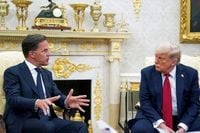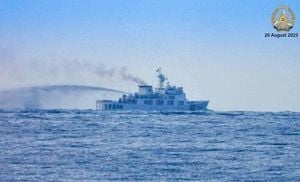In the wake of escalating geopolitical tensions and the ongoing war in Ukraine, Europe is undergoing a dramatic transformation in its defense, energy, and infrastructure sectors. From Estonia's ambitious defense modernization to the record-breaking investment booms in military manufacturing, the continent is entering a new era—one defined by unprecedented spending, international cooperation, and a race to secure both its borders and its economic future.
On July 11, 2025, a striking scene unfolded off the coast of Saaremaa, Estonia: reservists practiced live fire with the country's HIMARS systems for the first time. This exercise, according to ERR, was more than just a show of military readiness. It was a signal that Estonia is taking bold steps to strengthen its defenses in response to the shifting security landscape of Eastern Europe. At the heart of this effort is Estonia's plan to take out up to €3.6 billion in loans—supported by the European Commission—to fund a sweeping array of defense initiatives.
Estonia's move is part of a larger European rearmament plan, proposed by the European Commission in the spring of 2025. The plan envisions borrowing up to €150 billion on behalf of EU member states, then lending these funds out for defense investments. The logic is simple: by pooling their borrowing power, member states can secure better loan terms than if they went it alone. As Janno Luurmees, director of the State Treasury Department at Estonia's Ministry of Finance, told ERR, "Estonia is interested." He confirmed that the Ministry of Defense has already drawn up an initial loan interest request and submitted it to the European Commission, though the process remains in its early stages.
The exact amount Estonia will borrow is still up in the air, with estimates ranging from €2 billion to €3.6 billion, and potential loan terms stretching up to 45 years. What is clear, however, is the financial advantage: for every €1 billion borrowed, Estonia expects to save about €4 million annually thanks to lower interest rates compared to its own national bonds. "If you look at the current difference in interest rates between Estonia's ten-year bond and the European Commission's ten-year bond, it's roughly 0.4 percent. The benefit would likely be around that," Luurmees explained to ERR.
There are strings attached, of course. At least two-thirds of the final components in any purchased defense products must be of EU origin or come from EU industry. But for Estonia, the benefits outweigh the restrictions. The planned defense loan will fund everything from medium- and short-range air defense missiles and artillery shells to infantry fighting vehicles (IFVs), the Baltic Defense Line, and an expanded Navy fleet. Kalle Kirss, head of the NATO and European Union Department at Estonia's Ministry of Defense, emphasized to ERR that joint procurements with other countries are a key part of the strategy. "We actually have joint procurements with countries in the region in several cases," he said, noting previous collaborations with Latvia and Germany on IRIS-T medium-range air defense systems.
Estonia's government is now tasked with drawing up a detailed plan for these projects, which must be submitted to the European Commission by the end of November 2025. The clock is ticking, but the stakes—and the potential rewards—are higher than ever.
This surge in defense spending is not unique to Estonia. Across Eastern Europe, the war in Ukraine has acted as a catalyst for massive investments in military, energy, and infrastructure sectors. According to AINvest, since February 2022, the United States has committed $66.5 billion in military aid to Ukraine. Allies like the UK and NATO members have chipped in an additional €40 billion in 2025 alone. The demand for advanced systems—HIMARS, Abrams tanks, air defense batteries—and innovations in drones and cyber warfare has soared.
The U.S.-Ukraine Reconstruction Investment Fund, which includes access to Ukraine's natural resources, further underscores the strategic alignment between defense and economic recovery. Defense contractors such as BAE Systems and Raytheon Technologies are thriving: BAE's recent $104 million Foreign Military Sale for M777 howitzer support services is just one example of the sector's resilience, with a 22% increase in demand since 2022. European defense stocks, including Germany's Rheinmetall and Sweden's Saab, have also posted double-digit gains as NATO members ramp up spending.
But this boom is not without its risks. As AINvest notes, the Trump administration's focus on reallocating U.S. stockpiles to Ukraine—sometimes diverting interceptor missiles for domestic use—could inject short-term volatility into the market. Investors are advised to keep a close eye on congressional debates and NATO coordination to assess the sustainability of these aid flows.
Energy infrastructure is another front in this new era. President Volodymyr Zelenskyy's push for energy resilience has attracted €120 million from the European Investment Bank (EIB) for hydropower plant rehabilitation and €100 million for district heating upgrades. Solar and wind capacity in Ukraine is expected to grow by 30% in 2025, while the EIB's Just Transition and Resilience Program is targeting coal-dependent regions for clean-tech investment. The EU-backed Ukraine FIRST initiative has already provided €30 million to accelerate projects like Ukrnafta's gas-fired power plants and the reconstruction of the M-15 highway. There’s been a 45% increase in funding for green projects, signaling robust institutional support.
Of course, the shadow of war looms large. Russian attacks on Ukraine's energy infrastructure have forced a delicate balancing act between short-term repairs and long-term planning. Investors are encouraged to hedge their exposure to energy stocks against the risk of further geopolitical shocks.
Infrastructure, too, is seeing a renaissance. The EU has allocated €500 million in equity funds to support Ukraine’s EU accession and reconstruction efforts, including the InvestEU Ukraine Export Credit Pilot, which reduces financial risks for EU exports to Ukraine. Major projects like the M-15 highway in Odesa are just the beginning. The EU’s €11.1 billion European Peace Facility and the G7's use of frozen Russian assets are funneling billions into reconstruction and defense industrialization. Germany and Poland, for their part, have increased their military budgets by 28% and 31% respectively in 2025, reflecting a continent-wide trend.
This flood of investment is fueling one of the biggest booms in European financial markets. As reported by Bloomberg, when NATO leaders gathered in The Hague in late June to plot a radical boost in military spending, investors in London were clamoring for a piece of the action. A Czech maker of armored vehicles and ammunition saw investor orders for a bond sale exceed $10 billion—ten times the expected amount—prompting the company to double the sale to over $2 billion and slash interest rates. Spanish explosives maker Maxam Prill, despite its mining industry profile, raised $1.4 billion in junk bonds as investors zeroed in on its military applications.
Europe's credit markets are now the primary source of cash for manufacturers racing to fill trillions of euros worth of government orders for tanks, bombs, and guns. The stock market may grab the headlines with 100% and 200% rallies in defense companies, but it's the quiet churn of the credit markets that's enabling this unprecedented ramp-up in production.
For investors and policymakers alike, the message is clear: the intersection of defense, energy, and infrastructure is now the beating heart of Europe's long-term security and economic strategy. As the continent adapts to new realities, those willing to navigate the complexities—and the risks—may find themselves at the forefront of a historic transformation.
In this climate of uncertainty and opportunity, Estonia's decisive steps, Ukraine's resilience, and Europe's financial might are converging to shape a future that will be watched closely far beyond the continent's borders.




